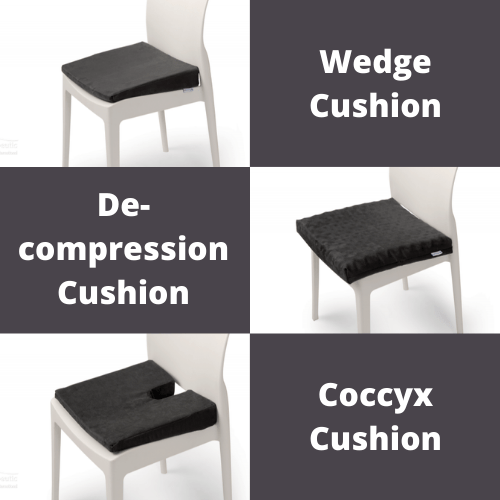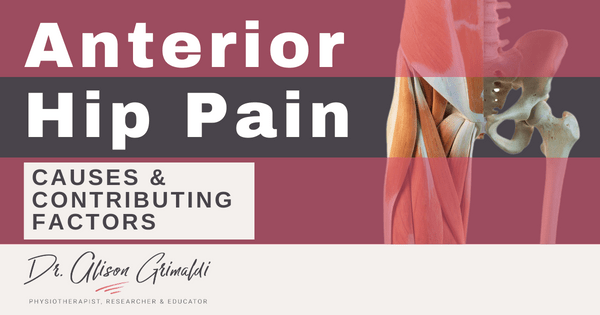Hip Tip 6 – Try a cushion

Wow! It's Day 6! We're already half way through these 12 Hip Tips. Hope you've been finding them helpful so far. Today I'll be talking about improving comfort in sitting, for those with hip pain. And I have a product recommendation for you, to assist with this aim. If you've missed any of the previous hip tips, you can visit the blog listing page here.
Tip #6 Try a cushion to reduce pain in sitting and on rising to stand
Hip pain in sitting is one of the most common problems our patients report. Difficulties may be associated with:
- prolonged periods of sitting
- rising to stand and walk
- getting in and out of the car
An inability to sit comfortably can have a profound impact on quality of life. The advent of standing work stations has provided a partial solution for office workers, but standing all day is very fatiguing and has it's own set of challenges.

Further, there are times where it is simply impractical not to sit. Driving requires an upright sitting position and even as a passenger in a car, plane or during longer distance bus or train travel, some period of upright sitting is usually required. Also, especially at this time of year where social gatherings are more frequent, periods of sitting are typically involved. With returning to restaurants and pubs after our Covid-19 lock-downs, in Australia all diners/drinkers were required to sit, with no standing to mingle or to order permitted. An inability to sit meant an inability to get out of the house to socialise in these venues.
Cushions that help reduce hip and pelvic pain in sitting:
1. Wedge cushion
Common conditions that are helped with a wedge cushion:
- Hip osteoarthritis (OA)
- Femoroacetabular impingement syndrome (hip impingement)
- Labral tears
- Hip pain associated with acetabular dysplasia
- Gluteal tendinopathy/Greater Trochanteric Pain Syndrome (GTPS)
Chondrolabral pathology that may progress to OA is most common in the anterior-superior aspect of the joint. Sustained deep flexion of 90degrees or more tends to be provocative, so the deeper the chair - the more irritation. For those with cam morphology or osteophytosis associated with hip OA, femoroacetabular contact relatively early in range may result in compression of the labrum and/or increased pressure on nociceptive subchondral bone. Differing degrees of flexion will be tolerated by different people depending on their presentation, but as a general rule, keeping the hips a little higher than the knees (hips more open than 90 degrees) can be helpful.
For those with acetabular dysplasia and reduced anterior acetabular coverage of the femoral head, higher loads are placed on the anterior rim structures, including the labrum. Sitting in posterior pelvic tilt is likely to increase this anterior rim loading. A wedge cushion +/- lumbar support as required, can assist in reducing the anterior loads and pain that some may experience with prolonged sitting or driving.
Using a wedge is also helpful for people with gluteal tendinopathy/GTPS. While sustained adduction is a potent aggravating factor for those with gluteal tendinopathy, hip flexion can add to compressive loads at the lateral hip due to fascial connections between the ITB, fascia lata, gluteal fascia and thoracodorsal fascia. Greater hip flexion increases the chances of higher compression, particularly when combined with hip adduction i.e. sitting in a low chair with the knees crossed.
A wedge cushion is great for reducing hip flexion in sitting and is often more successful than tilting the seat-base of the chair. It needs to be a high-quality, medium density foam though to have adequate effect. We have tried many over the years – this is the one we recommend to our patients with great feedback - click the button below to view.
2. Decompression cushion
Common conditions that are helped with a decompression cushion
- Proximal hamstring tendinopathy
- Nerve-related buttock pain e.g. deep gluteal syndrome
For those who can’t sit simply because of the pressure against the base of the seat, a decompression cushion can be useful to extend sitting tolerance and improve functional capacity while you address underlying causes. Those with proximal hamstring tendinopathy will often have localised discomfort over the hamstring tendon origin at the ischial tuberosity – you’ll often find them in the waiting room sitting on one buttock cheek. Not sustainable for long periods! A waffle style decompression cushion will often soften the chair enough to improve comfort and sitting tolerance. If the pain is more severe, sometimes it is necessary to cut holes in a piece of thick medium density foam, in the location of the ischial tuberosities.
Those with nerve related buttock pain may also be quite sensitive to the pressure of sitting. A decompression cushion can be useful in these situations. Depending on the underlying factors of this nerve related pain, a lumbar support may also be required and/or you could trial a wedge if their pain is more related to position rather than pressure.
Click the button below to view the multipurpose (decompression) cushion we use in our clinic.
3. Coccyx Cushion
For those who experience that exquisite tenderness on the tip of the tailbone when sitting or on rising to stand after sitting (coccydynia), removing the sustained pressure on the coccyx can make all the difference to comfortable sitting. We have found that combining a cut out with a wedge shape is often most effective, as it naturally reduces posterior pelvic tilt. Often those with coccydynia tend to sit perched in a rigid upright position, fearful of relaxing into any posterior pelvic tilt. This is very fatiguing and may contribute to secondary lower back pain. A coccyx wedge cushion paired with a lumbar support will often help the patient to achieve a relaxed sitting position for a much longer period.
Click the button below to view the coccyx cushion we use in our clinic. This one incorporates a wedge shape to move the weight forward, away from the coccyx - usually best used in conjunction with a back support. If the wedge is not suitable for your patient, the coccyx shape without the wedge shape is available here: Coccyx Diffuser Cushion
Your Day 6 shares are these product recommendations:

You can view or purchase any of these cushions we use in my clinic, at PhysioTec.
There is a broader range here at
PhysioTec Pillow Page
I hope these tips and product recommendations can help you with managing your patient’s sitting pain or to improve your own sitting comfort during the sustained sitting often involved with socialising and travelling during the holiday season (albeit less international travel this year!). See you tomorrow for Day 7.
Click on the box above to read Day 5 miniblog
Click on the box above to read Day 7 miniblog
Another great Anterior Hip Pain blog

Anterior Hip Pain: Causes & Contributing Factors
Adequate consideration of individual causes and contributing factors is important for best outcomes.



